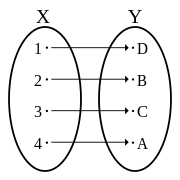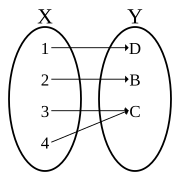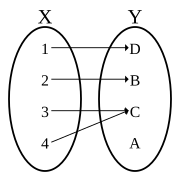Top Qs
Timeline
Chat
Perspective
Injective function
Function that preserves distinctness From Wikipedia, the free encyclopedia
Remove ads
Remove ads
In mathematics, an injective function (also known as injection, or one-to-one function[1] ) is a function f that maps distinct elements of its domain to distinct elements of its codomain; that is, x1 ≠ x2 implies f(x1) ≠ f(x2) (equivalently by contraposition, f(x1) = f(x2) implies x1 = x2). In other words, every element of the function's codomain is the image of at most one element of its domain.[2] The term one-to-one function must not be confused with one-to-one correspondence that refers to bijective functions, which are functions such that each element in the codomain is an image of exactly one element in the domain.
A homomorphism between algebraic structures is a function that is compatible with the operations of the structures. For all common algebraic structures, and, in particular for vector spaces, an injective homomorphism is also called a monomorphism. However, in the more general context of category theory, the definition of a monomorphism differs from that of an injective homomorphism.[3] This is thus a theorem that they are equivalent for algebraic structures; see Homomorphism § Monomorphism for more details.
A function that is not injective is sometimes called many-to-one.[2]
Remove ads
Definition

Let be a function whose domain is a set The function is said to be injective provided that for all and in if then ; that is, implies Equivalently, if then in the contrapositive statement.
Symbolically, which is logically equivalent to the contrapositive,[4]An injective function (or, more generally, a monomorphism) is often denoted by using the specialized arrows ↣ or ↪ (for example, or ), although some authors specifically reserve ↪ for an inclusion map.[5]
Remove ads
Examples
Summarize
Perspective
For visual examples, readers are directed to the gallery section.
- For any set and any subset the inclusion map (which sends any element to itself) is injective. In particular, the identity function is always injective (and in fact bijective).
- If the domain of a function is the empty set, then the function is the empty function, which is injective.
- If the domain of a function has one element (that is, it is a singleton set), then the function is always injective.
- The function defined by is injective.
- The function defined by is not injective, because (for example) However, if is redefined so that its domain is the non-negative real numbers [0,+∞), then is injective.
- The exponential function defined by is injective (but not surjective, as no real value maps to a negative number).
- The natural logarithm function defined by is injective.
- The function defined by is not injective, since, for example,
More generally, when and are both the real line then an injective function is one whose graph is never intersected by any horizontal line more than once. This principle is referred to as the horizontal line test.[2]
Remove ads
Injections can be undone
Functions with left inverses are always injections. That is, given if there is a function such that for every , , then is injective. In this case, is called a retraction of Conversely, is called a section of
Conversely, every injection with a non-empty domain has a left inverse . It can be defined by choosing an element in the domain of and setting to the unique element of the pre-image (if it is non-empty) or to (otherwise).[6]
The left inverse is not necessarily an inverse of because the composition in the other order, may differ from the identity on In other words, an injective function can be "reversed" by a left inverse, but is not necessarily invertible, which requires that the function is bijective.
Remove ads
Injections may be made invertible
Summarize
Perspective
In fact, to turn an injective function into a bijective (hence invertible) function, it suffices to replace its codomain by its actual image That is, let such that for all ; then is bijective. Indeed, can be factored as where is the inclusion function from into
More generally, injective partial functions are called partial bijections.
Remove ads
Other properties

- If and are both injective then is injective.
- If is injective, then is injective (but need not be).
- is injective if and only if, given any functions whenever then In other words, injective functions are precisely the monomorphisms in the category Set of sets.
- If is injective and is a subset of then Thus, can be recovered from its image
- If is injective and and are both subsets of then
- Every function can be decomposed as for a suitable injection and surjection This decomposition is unique up to isomorphism, and may be thought of as the inclusion function of the range of as a subset of the codomain of
- If is an injective function, then has at least as many elements as in the sense of cardinal numbers. In particular, if, in addition, there is an injection from to then and have the same cardinal number. (This is known as the Cantor–Bernstein–Schroeder theorem.)
- If both and are finite with the same number of elements, then is injective if and only if is surjective (in which case is bijective).
- An injective function which is a homomorphism between two algebraic structures is an embedding.
- Unlike surjectivity, which is a relation between the graph of a function and its codomain, injectivity is a property of the graph of the function alone; that is, whether a function is injective can be decided by only considering the graph (and not the codomain) of
Remove ads
Proving that functions are injective
A proof that a function is injective depends on how the function is presented and what properties the function holds. For functions that are given by some formula there is a basic idea. We use the definition of injectivity, namely that if then [7]
Here is an example:
Proof: Let Suppose So implies which implies Therefore, it follows from the definition that is injective.
There are multiple other methods of proving that a function is injective. For example, in calculus if is a differentiable function defined on some interval, then it is sufficient to show that the derivative is always positive or always negative on that interval. In linear algebra, if is a linear transformation it is sufficient to show that the kernel of contains only the zero vector. If is a function with finite domain it is sufficient to look through the list of images of each domain element and check that no image occurs twice on the list.
A graphical approach for a real-valued function of a real variable is the horizontal line test. If every horizontal line intersects the curve of in at most one point, then is injective or one-to-one.
Remove ads
Gallery
- Not an injective function. Here and are subsets of and are subsets of : for two regions where the function is not injective because more than one domain element can map to a single range element. That is, it is possible for more than one in to map to the same in
- Making functions injective. The previous function can be reduced to one or more injective functions (say) and shown by solid curves (long-dash parts of initial curve are not mapped to anymore). Notice how the rule has not changed – only the domain and range. and are subsets of and are subsets of : for two regions where the initial function can be made injective so that one domain element can map to a single range element. That is, only one in maps to one in
- Injective functions. Diagramatic interpretation in the Cartesian plane, defined by the mapping where domain of function, range of function, and denotes image of Every one in maps to exactly one unique in The circled parts of the axes represent domain and range sets— in accordance with the standard diagrams above
Remove ads
See also
- Bijection, injection and surjection – Properties of mathematical functions
- Injective metric space – Type of metric space
- Monotonic function – Order-preserving mathematical function
- Univalent function – Mathematical concept
Notes
References
External links
Wikiwand - on
Seamless Wikipedia browsing. On steroids.
Remove ads









































![{\displaystyle f^{-1}[y]}](http://wikimedia.org/api/rest_v1/media/math/render/svg/c5ffa43f26ddc0c27fedee54ea4051661d56fa21)




















































